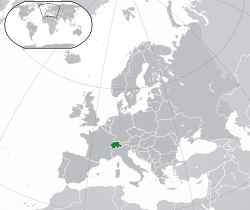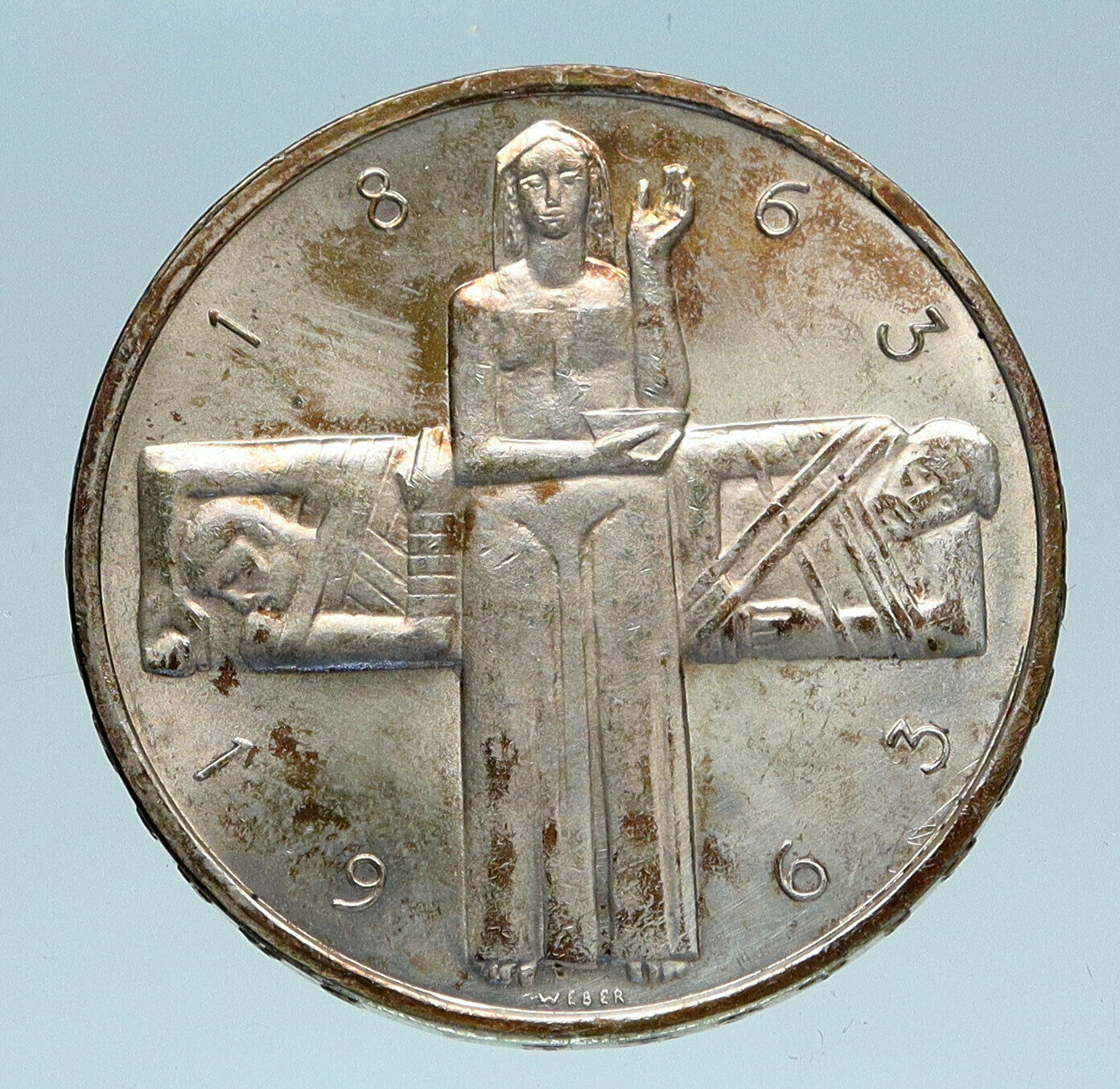|
Switzerland
– Swiss Canton of Vaud
1828 Silver 1 Batzen (10 Rappen) 25mm (2.40 grams) 0.160 Silver
Reference: KM# 20, HMZ 1# 2-1004
CANTON DE VAUD 1829 LIBERTE ET PATRIE 1 BATZ, Shield between branches.
LES CANTONS CONCORDANTS DE LA SUISSE, Wide cross within ornate border.
You are bidding on the exact item pictured, provided with a Certificate of Authenticity and Lifetime Guarantee of Authenticity.
The canton of Vaud is the third largest of the Swiss cantons by population and fourth by size. It is located in Romandy, the French-speaking western part of the country; and borders the canton of Neuchâtel to the north, the cantons of Fribourg and Bern to the east, Valais and Lake Geneva to the south, the canton of Geneva to the south-west and France (Auvergne-Rhône-Alpes and Bourgogne-Franche-Comté) to the west.
The capital and biggest city is Lausanne, officially designated “Olympic Capital” by the International Olympic Committee and hosts many international sports organizations. As of 2017 the canton has a population of 793,129.
Along the lakes, Vaud was inhabited in prehistoric times. Later, the Celtic tribe of the Helvetii inhabited the area. The tribe was defeated by Caesar’s troops in 58 BC and as a consequence the Romans settled the area. The towns of Vevey (Latin: Viviscus) and Lausanne (Lausonium or Lausonna) are two of the many towns established by the Romans.
In 27 BC the state of Civitas Helvetiorum was established around the capital of Avenches (Aventicum). There are still many Roman remains around the town today. Between the 2nd and the 4th century the area was repeatedly invaded by Alemannic tribes, and in the 5th century the Burgundians occupied the area. The Merovingian Franks later replaced the Burgundians. Their occupancy did not last long either, and in 888 the area of the canton of Vaud was made part of the Carolingian Empire. In 1032 the Zähringens of Germany defeated the Burgundians. The Zähringens themselves were succeeded in 1218 by the counts of Savoy. It was only under the counts of Savoy that the area was given political unity, establishing the Barony of Vaud. A part stretching from Attalens to the River Sarine, in the north, was absorbed by the canton of Fribourg.
As the power of the Savoys declined at the beginning of the 15th century the land was occupied by troops from Bern. By 1536 the area was completely annexed. Reformation was started by co-workers of John Calvin like Pierre Viret, including a famous debate at the cathedral of Lausanne; but it was only decisively implemented when Bern put its full force behind it.
The Bernese occupiers were not popular amongst the population. In 1723, Major Abraham Davel led a revolt against Bern, in protest at what he saw as the denial of political rights of the French-speaking Vaudois by the German-speaking Bernese, and was subsequently beheaded. Later, inspired by the French Revolution, the Vaudois drove out the Bernese governor in 1798 and declared the Lemanic Republic. Vaud nationalists like Frédéric-César de La Harpe had called for French intervention in liberating the area and French Revolutionary troops moved in, taking over the whole of Switzerland itself in the process and setting up the Helvetic Republic. Under Napoleon I, it became the canton of Léman. Unrest about the abolition of feudal rights and taxes led to increased discontent, which culminated in the revolt of the Bourla-papey in Spring 1802, closely followed by the Stecklikrieg that brought the end of the entire Helvetic Republic. In 1803, Vaud joined the re-installed Swiss confederation. In spite of Bernese attempts to reclaim Vaud, it has remained a sovereign canton ever since.
In the 19th century, the canton of Vaud was an outspoken opponent of the Sonderbund Catholic separatist movement, which led to intervention in 1847 by 99,000 Swiss Federal troops under General Henri Dufour against 79,000 separatists, in what is called the Sonderbund War. Separation was prevented at the cost of very few lives. The current constitution dates from 14 April 2003, replacing the one from 1885.
The canton stretches from Lake Neuchâtel in the north, where it borders the canton of Neuchâtel, to Lake Geneva (French: Léman) in the south, where it borders the canton of Geneva, the French department of Haute-Savoie (lake border) and the canton of Valais (Chablais). In the Jura mountains in the west, the canton borders the French departments of Ain, Jura, and Doubs. In the east, it borders the cantons of Fribourg and Bern. The total area is 3,212 square kilometres (1,240 sq mi).
Along with the canton of Berne, Vaud is one of the two cantons whose territory extends from the Jura to the Alps, through the three distinct geographic regions of Switzerland.
The areas in the south east are mountainous, situated on the north side of the Bernese Alps. This region is commonly named the Vaud Alps (French: Alpes Vaudoises). The Diablerets massif, peaking at 3,210 metres (10,531 ft), is the highest mountain of the canton. Other summits such as the Grand Muveran and the Tour d’Aï are visible from most of the canton. The area also hosts several popular skiing destinations such as Villars, Les Diablerets and Leysin.
The central area of the canton, in contrast, consists of moraines and is hilly. There are plains along the lakes. In the north, Avenches is in an exclave of the canton surrounded by the canton of Fribourg and Lake Neuchâtel. On the other hand, there are three enclaves of the canton of Fribourg (Estavayer-le-lac, Vuissens, Surpierre), as well as two enclaves of the canton of Geneva (Céligny), that are surrounded by the canton of Vaud.
The north-western part of the canton is also mountainous but in a more modest way with mountains generally not above 1,500 metres (4,900 ft); the Jura Mountains. The Vallée de Joux is one of the most popular destinations in the region and also a centre of luxury mechanical Swiss watch manufacturing.
.svg/85px-Coat_of_Arms_of_Switzerland_(Pantone).svg.png)  Switzerland, officially the Swiss Confederation (Latin: Confoederatio Helvetica, hence its abbreviation CH), is a federal parliamentary republic consisting of 26 cantons, with Bern as the seat of the federal authorities, the so-called Bundesstadt (“federal city”). The country is situated in Western and Central Europe, where it is bordered by Italy to the south, France to the west, Germany to the north, and Austria and Liechtenstein to the east. Switzerland is a landlocked country geographically divided between the Alps, the Swiss Plateau and the Jura, spanning an area of 41,285 km2 (15,940 sq mi). While the Alps occupy the greater part of the territory, the Swiss population of approximately 8 million people is concentrated mostly on the Plateau, where the largest cities are to be found. Among them are the two global cities and economic centres of Zürich and Geneva. Switzerland, officially the Swiss Confederation (Latin: Confoederatio Helvetica, hence its abbreviation CH), is a federal parliamentary republic consisting of 26 cantons, with Bern as the seat of the federal authorities, the so-called Bundesstadt (“federal city”). The country is situated in Western and Central Europe, where it is bordered by Italy to the south, France to the west, Germany to the north, and Austria and Liechtenstein to the east. Switzerland is a landlocked country geographically divided between the Alps, the Swiss Plateau and the Jura, spanning an area of 41,285 km2 (15,940 sq mi). While the Alps occupy the greater part of the territory, the Swiss population of approximately 8 million people is concentrated mostly on the Plateau, where the largest cities are to be found. Among them are the two global cities and economic centres of Zürich and Geneva.
The establishment of the Swiss Confederation is traditionally dated to 1 August 1291, which is celebrated annually as Swiss National Day. It has a long history of armed neutrality-it has not been in a state of war internationally since 1815-and did not join the United Nations until 2002. It pursues, however, an active foreign policy and is frequently involved in peace-building processes around the world. Switzerland is also the birthplace of the Red Cross and home to numerous international organizations, including the second largest UN office. On the European level, it is a founding member of the European Free Trade Association and is part of the Schengen Area – although it is notably not a member of the European Union, nor the European Economic Area. Switzerland comprises four main linguistic and cultural regions: German, French, Italian and the Romansh-speaking valleys. Therefore, the Swiss, although predominantly German-speaking, do not form a nation in the sense of a common ethnic or linguistic identity; rather, the strong sense of identity and community is founded on a common historical background, shared values such as federalism and direct democracy, and Alpine symbolism.
Switzerland has the highest nominal wealth per adult (financial and non-financial assets) in the world according to Credit Suisse and eighth-highest per capita gross domestic product on the IMF list. However, Switzerland is also the most expensive country in the world to live in, as measured by the price level index.
Swiss citizens have the second-highest life expectancy in the world on the UN DESA list. Switzerland is tied with the Netherlands for the top rank on the Bribe Payers Index indicating very low levels of business corruption. Moreover, for the last five years the country has been ranked first in economic and tourist competitiveness according to the Global Competitiveness Report and the Travel and Tourism Competitiveness Report respectively, both developed by the World Economic Forum. Zürich and Geneva have each been ranked among the top cities with the highest quality of life in the world, with the former coming second globally according to Mercer. However, Mercer also rates those two cities as the fifth- and sixth- most expensive cities in the world to live in.
|





.svg/85px-Coat_of_Arms_of_Switzerland_(Pantone).svg.png)
 Switzerland, officially the Swiss Confederation (Latin: Confoederatio Helvetica, hence its abbreviation CH), is a federal parliamentary republic consisting of 26 cantons, with Bern as the seat of the federal authorities, the so-called Bundesstadt (“federal city”). The country is situated in Western and Central Europe, where it is bordered by Italy to the south, France to the west, Germany to the north, and Austria and Liechtenstein to the east. Switzerland is a landlocked country geographically divided between the Alps, the Swiss Plateau and the Jura, spanning an area of 41,285 km2 (15,940 sq mi). While the Alps occupy the greater part of the territory, the Swiss population of approximately 8 million people is concentrated mostly on the Plateau, where the largest cities are to be found. Among them are the two global cities and economic centres of Zürich and Geneva.
Switzerland, officially the Swiss Confederation (Latin: Confoederatio Helvetica, hence its abbreviation CH), is a federal parliamentary republic consisting of 26 cantons, with Bern as the seat of the federal authorities, the so-called Bundesstadt (“federal city”). The country is situated in Western and Central Europe, where it is bordered by Italy to the south, France to the west, Germany to the north, and Austria and Liechtenstein to the east. Switzerland is a landlocked country geographically divided between the Alps, the Swiss Plateau and the Jura, spanning an area of 41,285 km2 (15,940 sq mi). While the Alps occupy the greater part of the territory, the Swiss population of approximately 8 million people is concentrated mostly on the Plateau, where the largest cities are to be found. Among them are the two global cities and economic centres of Zürich and Geneva.




